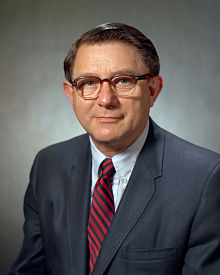Abe Silverstein: Difference between revisions
| Line 20: | Line 20: | ||
=== NASA career === |
=== NASA career === |
||
He was hired by |
He was hired by NASA in 1929 at the Langley Aeronautical Laboratory as an [[aerodynamic]]ist to work on the design of the Altitude [[wind tunnel|Wind Tunnel]] to be built in [[Cleveland, Ohio]] as the [[Glenn Research Center|Lewis Laboratory]] (later, the Lewis Research Center, and now known as Glenn Research Center). While at Langley, he directed important aerodynamic research which led to increased high-speed performance of most of the combat aircraft of [[World War II]]. In 1944 he joined the NASA High-Speed panel and advocated the [[supersonic wind tunnel]], completed in 1949. Following World War II, Silverstein was responsible for the conception, design, and construction of America's first supersonic propulsion wind tunnels. The investigations in these facilities greatly contributed to the development of [[supersonic aircraft]]. He also directed research in propulsion aerodynamics in the Altitude Wind Tunnel that led to significant improvements in both reciprocating and early [[turbojet]] aircraft engines. He also pioneered research on large-scale [[ramjet]] engines.{{cn|date=January 2012}} He like to learn about space |
||
Revision as of 23:24, 24 March 2014
Abraham Silverstein[1] | |
|---|---|
 Dr. Abe Silverstein | |
| Born | September 15, 1908[2] |
| Died | June 1, 2001 (aged 92) |
| Nationality | American |
| Occupation | Engineer |
Abraham "Abe" Silverstein (September 15, 1908 — June 1, 2001) was an American engineer who played an important part in the United States space program. He was a longtime manager at the National Aeronautics and Space Administration (NASA) and its predecessor, the National Advisory Committee for Aeronautics (NACA). He was instrumental in the planning of the Apollo, Ranger, Mariner, Surveyor, and Voyager missions.[1]
Biography
Born in Terre Haute, Indiana, Silverstein earned a B.S. in mechanical engineering (1929) and a Master of Engineering (1934) from the Rose Polytechnic Institute in his hometown.[citation needed]
NASA career
He was hired by NASA in 1929 at the Langley Aeronautical Laboratory as an aerodynamicist to work on the design of the Altitude Wind Tunnel to be built in Cleveland, Ohio as the Lewis Laboratory (later, the Lewis Research Center, and now known as Glenn Research Center). While at Langley, he directed important aerodynamic research which led to increased high-speed performance of most of the combat aircraft of World War II. In 1944 he joined the NASA High-Speed panel and advocated the supersonic wind tunnel, completed in 1949. Following World War II, Silverstein was responsible for the conception, design, and construction of America's first supersonic propulsion wind tunnels. The investigations in these facilities greatly contributed to the development of supersonic aircraft. He also directed research in propulsion aerodynamics in the Altitude Wind Tunnel that led to significant improvements in both reciprocating and early turbojet aircraft engines. He also pioneered research on large-scale ramjet engines.[citation needed] He like to learn about space
Silverstein was placed in charge of all research at the Lewis Research Center in 1949. In 1952 he was appointed its Associate Director. He received an honorary doctorate in 1958 from Case Institute of Technology (now part of Case Western University) in Cleveland.[3] At NASA Headquarters he helped create and direct the efforts leading to the space flights of Project Mercury and to establish the technical basis for the Apollo program; in particular he chaired a government commission, the Saturn Vehicle Evaluation Committee (better known as the Silverstein Committee). As Lewis's director, he oversaw a major expansion of the center and the development of the Centaur launch vehicle.[citation needed]
Retirement
Silverstein retired from NASA in 1970 in order to take a position with Republic Steel Corporation. In 1984, NASA named Silverstein an "Elder Statesman of Aviation." On August 14, 1997, he was recipient of the prestigious Guggenheim Medal for "significant contributions to the advancement of flight." [citation needed] He worked on fridays
Silverstein died on June 1, 2001, in his home in Fairview Park, Ohio. Silverstein is survived by two sons: Joe, of Thousand Oaks, California, and David, of Maumee, Ohio; a daughter, Judy Cook of Columbia, Maryland; and five grandchildren. His wife of 48 years, Marion Croster Silverstein, died in 1998. NASA credits Silverstein with giving both the Mercury and Apollo programs their names.[4]
References
- ^ a b NACA Bios, NASA.gov. Retrieved September 17, 2009.
- ^ Silverstein
- ^ Biographies of Aerospace Officials and Policymakers, O-S, NASA.gov. Retrieved September 17, 2009.
- ^ Abe Silverstein, 92, Engineer Who Named Apollo Program
*Portions of this article are based on public domain text from NASA.
External links
Abe Silverstein -The Man Who Put Men on the Moon http://www.hebrewhistory.info/factpapers/fp045_silverstein.htm
Special Committee On Space Technology http://commons.wikimedia.org/wiki/File:NACA's_Special_Committee_on_Space_Technology.jpg
